“Is Shopify Dropshipping Free?” Yes, it’s a burning question in the world of e-commerce. We’ll explore that today. Embarking on an entrepreneurial journey in the ever-evolving world of e-commerce is an enticing prospect. Among the various models that have gained immense popularity, dropshipping stands out as a low-risk, high-potential method for aspiring business owners.
It’s the art of selling without the hassle of stocking inventory. Dropshipping is an enticing prospect for entrepreneurs. In this guide, we’ll discuss the cost structure, saving strategies, and the impact of Shopify’s fees on your e-commerce venture. Let’s dive into the world of economical dropshipping.
Dropshipping Meaning?
Instead, when a company employs the dropshipping model to market a product, it purchases the good from a third party—typically a manufacturer or wholesaler—and sends it to the customer. As a result, direct product management is taken away from the vendor.
Dropshipping is a popular business model because it allows company owners to open an online store without investing in inventory. It is also a relatively low-risk business model, as the seller only pays for the product after it has been sold to the customer.
Here are some stats about dropshipping:
- The dropshipping market is expected to grow to $565.47 billion by 2027.
- Shopify is the leading e-commerce platform for dropshipping, with over 1 million merchants.
- 64% of Shopify users who start with a free trial upgrade to a paid plan within six months.
Dropshipping businesses work by selling products without having to carry any inventory. When a client orders from a dropshipping retailer, the store owner contacts the supplier to arrange for the goods to be delivered directly to the customer.
How do Dropshipping Businesses Work?
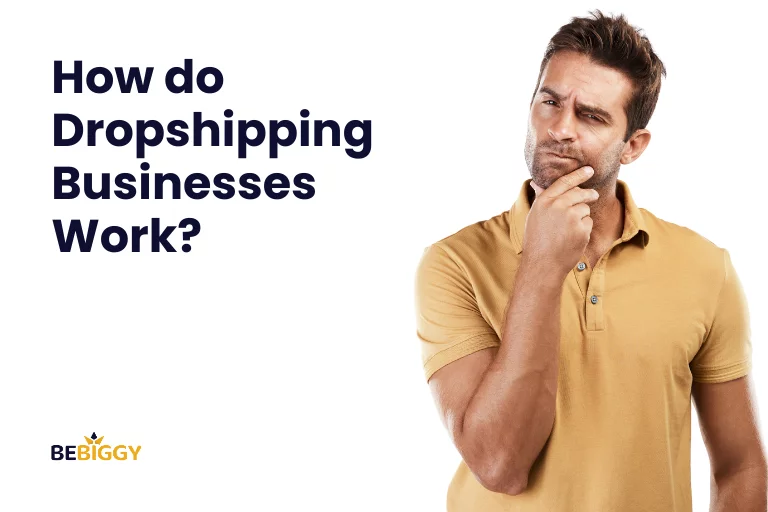
Here is a step-by-step guide on how dropshipping businesses work:
- At a dropshipping store, a consumer puts an order.
- The dropshipping store owner contacts the supplier and places the order.
- The provider sends the item straight to the customer.
- The customer receives the product, and the dropshipping store owner receives a payment from the customer.
Dropshipping businesses can be very profitable, but they are also very competitive. It is important to choose a niche, find reliable suppliers, and offer excellent customer service to be successful.
What is Shopify dropshipping?
Shopify dropshipping is an online business where you sell products without carrying any inventory. When a customer places an order on your Shopify store, you contact the supplier, who will ship the product directly.
A well-known e-commerce platform, Shopify, makes starting and running a dropshipping business simple. You may use Shopify’s numerous features and tools to automate product import and order fulfillment processes. Shopify also has a large app marketplace where you can find apps to add additional features and functionality to your store.
Here are some stats about Shopify dropshipping:
- The average Shopify dropshipper makes between $1,000 and $50,000 per month.
- The top 10% of Shopify dropshippers make over $100,000 per month.
How do you start dropshipping for free?
According to a recent study by Shopify, 37% of Shopify merchants started their businesses with less than $2,000. Starting a dropshipping business for free is possible, but it is important to be aware of the limitations.
For example, you may not have access to all the features and tools needed to build a successful dropshipping business. However, if you are on a tight budget, there are a few things you can do to get started.
Here is a step-by-step guide on how to start dropshipping for free:
- Choose a niche: Selecting a specialty for your dropshipping business is the first step. Because of this, you’ll be able to focus your marketing efforts on the right kind of customers.
- Find reliable suppliers: Once you have chosen a niche, you must find reliable suppliers who can ship products on time and within your budget. You can find suppliers through online directories or by attending trade shows.
- Create a free online store: Several e-commerce platforms, such as Shopify and WooCommerce, offer free trials. Choose a platform that is easy to use and that has the features you need.
- Add products to your store: Once you have generated your online store, you must add products. You can add products from your suppliers by importing them directly into your store.
- Start marketing your store: Once you have added products, you must start marketing them. Free marketing channels like social media and search engine optimization (SEO) can be used.
The Cost of Starting a Shopify Dropshipping Business
Starting a dropshipping business might range in price depending on several factors, such as the niche you choose, the suppliers you work with, and the features and tools you need. However, there are some general costs that you can expect to incur, including:
- E-commerce platform fees: Shopify is the most popular e-commerce platform for dropshipping, but other options, such as WooCommerce and Bebiggy, are available. Price plans for Shopify range from $26 per month and above.
- Domain name: Your domain name is your website’s online address. A domain registrar is where you go to register a domain name like GoDaddy or Namecheap. Domain names typically cost around $10 per year.
- Web hosting: The product or service that keeps the files on your website and makes them available to visitors. You have a variety of web hosting companies to pick from, and pricing might change based on the quality of service you want. Basic web hosting plans typically start around $5 per month.
- Payment processing fees: When a customer purchases on your website, you must pay a fee to the payment processor. Popular payment processors include PayPal and Stripe. Payment processing fees typically range from 5% to 3% of the transaction amount.
- Shipping costs: You must also pay for shipping your products to customers. Shipping prices might change depending on the size, weight, and location of your purchases.
However, starting a dropshipping business for less than $100 monthly is possible. As your company expands, you may invest in more features and tools to help you scale it.
What cost-saving strategies can individuals use for Shopify dropshipping?
There are several cost-saving strategies that individuals interested in pursuing Shopify dropshipping as a business can use. Here are a few:
- Use a free domain name registrar: Several free domain name registrars, such as Freenom, are available. Thus, it can help you to save money on domain name registration fees.
- Use a free web hosting provider: Several free web hosting providers, such as InfinityFree, are available. It helps you save money on web hosting fees.
- Use a free payment processor: Several free payment processors, such as PayPal, are available. It helps you to save money on payment processing fees.
- Compare shipping rates: When you ship products to customers, compare shipping rates from different carriers. It can help you to save money on shipping costs.
- Negotiate with suppliers: Many vendors are open to negotiations their prices, especially if you have a high sales volume. It can help you to increase your profit margins.
- Bundle products: Bundling products together can help you to increase your average order value and to reduce your shipping costs.
- Offer discounts: Offering discounts to customers can help you to attract new customers and to increase sales. However, be careful not to discount your products too much, which can erode your profit margins.
- Use free dropshipping apps: Some are available, such as Oberlo and AliDropship. This can help you save money on dropshipping app fees.
Here are some stats about Shopify dropshipping:
- Shopify dropshipping accounts for approximately 34% of all Amazon sales.
- The average Amazon dropshipper makes between $1,000 and $50,000 per month.
- The top 10% of Amazon dropshippers make over $100,000 per month.
- The worldwide dropshipping market is expected to reach $565.47 billion by 2027.
- Shopify is the leading e-commerce platform for dropshipping, with over 1 million merchants.
These figures demonstrate that Shopify dropshipping is an effective business strategy that may provide large revenues. However, it is important to be aware of the challenges involved and prepared to work to build a successful business.
Streamline Your Dropshipping Venture with BeBiggy
While cost-saving strategies are essential in Shopify dropshipping, some entrepreneurs prefer a more streamlined approach. BeBiggy, an industry-leading platform, simplifies the process by offering fully optimized pre-built Shopify stores for various niches. They provide a wide selection of fully optimized, ready-to-launch stores, making it easy for entrepreneurs to begin their journey at any stage. Whether you’re a seasoned pro or starting, BeBiggy simplifies the process, saving you time and effort.
Pros and cons of Shopify Dropshipping for free
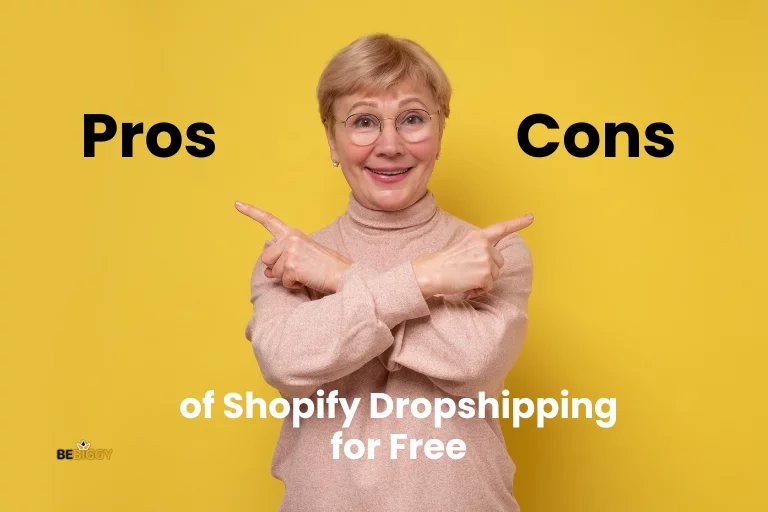
Pros
- Low Initial Cost: Starting a dropshipping business on Shopify with the free plan requires minimal upfront investment, making it an affordable option for beginners and entrepreneurs on a tight budget.
- Ease of Use: Shopify’s user-friendly platform allows newcomers to set up and manage online stores without advanced technical knowledge.
- Product Diversity: You can list a wide variety of products in your store without the need to purchase or hold inventory, allowing you to explore different niches and test products with minimal risk.
- Scalability: As your business grows, you can upgrade to a paid Shopify plan, which provides access to additional features and tools to support your expanding operations.
- Minimal Risk: Since you don’t invest in inventory upfront, you have lower financial risk than traditional retail businesses.
- Global Reach: Shopify enables you to reach a global audience, expanding your market potential.
- Easy Market Entry: Dropshipping eliminates the complexities of managing physical inventory, streamlining your business operations.
- Flexibility: Whenever there is an online connection, you can work, providing convenience and the potential for location independence.
- Reduced Overhead: You don’t need to worry about warehousing, shipping, or managing excess inventory, reducing overhead costs.
- Learning Opportunity: The free plan allows you to learn about e-commerce, marketing, and entrepreneurship without a significant financial commitment.
Cons
- Limited Features: The free plan has limited features compared to paid plans, which can restrict your ability to customize and optimize your store.
- Transaction Fees: Shopify charges transaction fees on each sale made through the free plan, which can eat into your profits.
- Branding Limitations: Some branding and customization options are restricted on the free plan, potentially limiting your store’s unique identity.
- Competition: The low barrier to entry means more competition in the dropshipping space, making it challenging to stand out.
- No Customer Support: You need access to priority customer support with the free plan, which can be a drawback if you encounter issues.
Are there hidden fees when setting up a Shopify dropshipping store?

There are some hidden fees that you may encounter when setting up a Shopify dropshipping store, but they are generally not significant.
Here are a few things to be aware of:
- Shopify transaction fees: Shopify charges a transaction fee on all sales made through your store. The fee varies depending on your Shopify plan, but it is typically between 2.9% and 3.9% 30 cents for each transaction and the sale price.
- Payment processing fees: When a customer purchases your Shopify store, you must also pay a fee to the payment processor. The fee varies depending on your payment processor, but it is typically around 2.5% of the sale price plus 30 cents per transaction.
- Dropshipping app fees: Many dropshipping apps charge a monthly fee. The fee varies depending on the app but is typically between $10 and $50 monthly.
- Shipping fees: You must also pay for shipping your products to customers. Depending on weight, shipping costs change and size of your products and the shipping destination.
In addition to these fees, you may encounter hidden fees, such as domain name registration fees, web hosting fees, and marketing costs. However, these fees are not specific to dropshipping businesses and apply to all online businesses.
What is the average income for Shopify dropshippers?
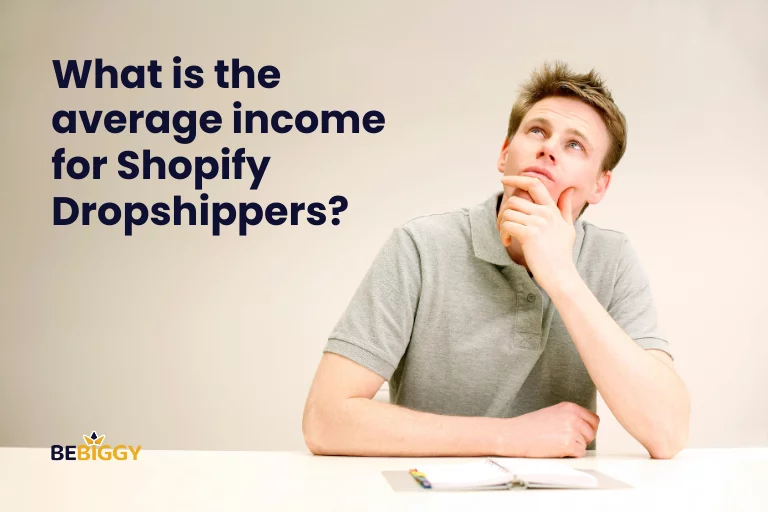
The average income for Shopify dropshippers varies depending on several factors, including the niche they choose, the suppliers they work with, the marketing efforts they put in, and the overall state of the economy. However, according to a recent study by Shopify, the average dropshipper makes between $1,000 and $5,000 per month.
Some of the top dropshippers in the world make much more than this, earning over $100,000 per month. However, it is essential to note that these are the top dropshippers, and most dropshippers do not make this much money.
How does Shopify dropshipping’s cost structure compare to traditional retail businesses?
Dropshipping has a much lower cost structure than traditional retail businesses. This is because dropshipping businesses do not need to carry any inventory, and they do not need to lease or own any retail space.
Here is a comparison of the cost structure of a dropshipping business to a traditional retail business:
| Types of Costs | Dropshipping Business | Traditional Retail Business |
| Inventory costs | None | High |
| Retail space costs | None | High |
| Staffing costs | Low (typically just the owner) | High |
| Marketing costs | Variable | Variable |
| Other costs | Transaction fees, payment processing fees, dropshipping app fees, shipping costs | Transaction fees, payment processing fees, inventory insurance, rent, utilities, payroll, etc. |
As you can see, the cost structure of a dropshipping business is much simpler and less expensive than the cost structure of a traditional retail business. It is one of the main reasons why dropshipping is such a popular business model.
How do Shopify’s pricing and transaction fees impact dropshipping business investments?
Shopify’s pricing and transaction fees can significantly impact dropshipping business investments.
Shopify offers several options, with monthly prices ranging from $26 to $399. Your plan will depend on the features and functionality you need for your business.
Additionally, Shopify levies transaction fees for each sale made by your store. The fee varies depending on your Shopify plan but is typically between 2.9% and 3.9% 30 cents for each transaction and the sale price.
In addition to Shopify’s pricing and transaction fees, there are several other costs that you will need to factor into your dropshipping business investments, such as domain name registration fees, web hosting fees, and marketing costs.
Here is a breakdown of how Shopify’s pricing and transaction fees impact dropshipping business investments:
- Startup costs: The startup costs of a dropshipping business are relatively low, especially compared to the startup costs of a traditional retail business. However, you will still need to factor in the cost of a Shopify plan, domain name registration, web hosting, and marketing.
- Ongoing costs: The ongoing costs of a dropshipping business are also relatively low. However, you must factor in Shopify’s transaction fees and the cost of products and shipping.
Here are some tips for reducing the impact of Shopify’s pricing and transaction fees on your dropshipping business investments:
- Choose the right Shopify plan: Shopify offers several options, with monthly prices ranging from $29 to $299. If you are just starting, start with the Basic plan.
- Negotiate with suppliers: Many vendors are open to negotiating their prices, especially if you have a high sales volume. This can increase your profit margins and offset the cost of Shopify’s transaction fees.
- Offer free or discounted shipping: Free or shipping can help attract customers and increase sales. However, be sure to factor the shipping cost into your product prices.
- Increase your average order value: Increasing your average order value can help offset the cost of Shopify’s transaction fees. You can do this by offering discounts on bulk orders or bundling products.
FAQs

Here are some FAQs related to your queries. Don’t worry; we will solve all of your queries.
Is dropshipping with Shopify free?
Dropshipping with Shopify is not free. Shopify charges a monthly fee for its platform and the accompanying transaction costs for each sale. However, there are several ways to reduce dropshipping costs with Shopify, such as choosing a free plan and negotiating with suppliers.
How much does Shopify dropshipping cost?
The cost of Shopify dropshipping varies depending on many factors, including the plan you choose, the transaction fees you pay, and the cost of products and shipping. However, you can expect to spend at least $29 per month on Shopify’s Basic plan, plus transaction fees and the cost of products and shipping.
Is dropshipping without investment?
Dropshipping is a business model that allows you to start an online business with very little investment. However, there are some costs that you will need to factor in, such as the cost of a Shopify plan, domain name registration, web hosting, and marketing.
Can you start dropshipping for free?
Yes, you can start dropshipping for free. There are several free Shopify plans available, and there are also several free dropshipping apps available. However, it is essential to note that you will still need to factor in the cost of products and shipping.
Is dropshipping 100% free?
No, dropshipping is not 100% free. There are always some costs associated with running a business, such as the cost of products and shipping. However, dropshipping is a business model that allows you to start an online business with very little investment.
What is the minimum profit for dropshipping?
The minimum profit for dropshipping varies depending on many factors, such as the cost of products, shipping, and Shopify’s transaction fees. Aiming for a profit margin of at least 20% is a decent general rule of thumb, nevertheless.
How to dropship with no money?
There are a few ways to dropship with no money. One way is to choose a free Shopify plan and use free dropshipping apps. Another way is to find suppliers willing to offer you credit terms.
Where can I purchase a prebuilt Shopify store?
You can buy a prebuilt Shopify store from BeBiggy. It has a comprehensive eCommerce store offering a wide selection of pre-built Shopify stores for your convenience.
How does Shopify pay you for dropshipping?
Shopify pays you for dropshipping through Shopify Payments. Shopify Payments is a payment processor that allows you to accept customer payments. Shopify will deposit the payments from your customers into your bank account regularly.
Does Shopify pay you directly?
Yes, Shopify pays you directly into your bank account. You must provide Shopify with your bank account information so they can deposit your customers’ payments.
How do I enable Shopify Payments in the USA?
- Go to your Shopify admin and click Settings > Payments.
- Click Activate Shopify Payments.
- Complete the required information and click Continue.
- Secure your account with two-step authentication.
- Add your banking information.
Once completed, Shopify Payments will be enabled on your Shopify store.
Is the Shopify store free?
No, Shopify stores aren’t free, though. A monthly subscription is required to utilize Shopify’s platform. Nevertheless, several free Shopify options are accessible, so you may launch a Shopify business without spending much money.
Can I use NayaPay for Shopify?
Yes, you can use NayaPay for Shopify. NayaPay is a Pakistani payment processor that Shopify supports.
Can I use Payoneer with Shopify?
Yes, you can use Payoneer with Shopify. Payoneer is a global payment processor that Shopify supports.
Is Shopify paid monthly?
Yes, Shopify is paid monthly. You will need to pay Shopify a monthly fee for its platform.
Does Shopify pay daily?
No, Shopify does not pay daily. Shopify deposits the payments from your customers into your bank account regularly, typically every 2-3.
Conclusion
In wrapping up our exploration of “Is Shopify Dropshipping Free? Exploring Costs and Investments,” it’s clear that the world of dropshipping on Shopify offers a tempting path to start your e-commerce adventure without breaking the bank. But as with any journey, there are twists and turns.
While the allure of a free Shopify plan is undeniable, remember that there’s more to the story. Hidden within the no-cost entry point are transaction fees and certain limitations. Your investment isn’t solely about money; it’s also about the time, effort, and strategy you put into your business.
So, weighing the pros and cons is vital if considering Shopify dropshipping. Consider your long-term goals, budget, and commitment to building a thriving online store. A free trial is an excellent place to start, but as you grow, be prepared to invest money and your dedication and creativity to stand out in the competitive e-commerce landscape.
Ultimately, Shopify offers a flexible platform that can scale with your ambitions. As you delve deeper into the world of e-commerce, remember that with the right strategy, patience, and a dash of entrepreneurial spirit, you can turn your dropshipping venture into a rewarding and profitable business. Happy dropshipping!

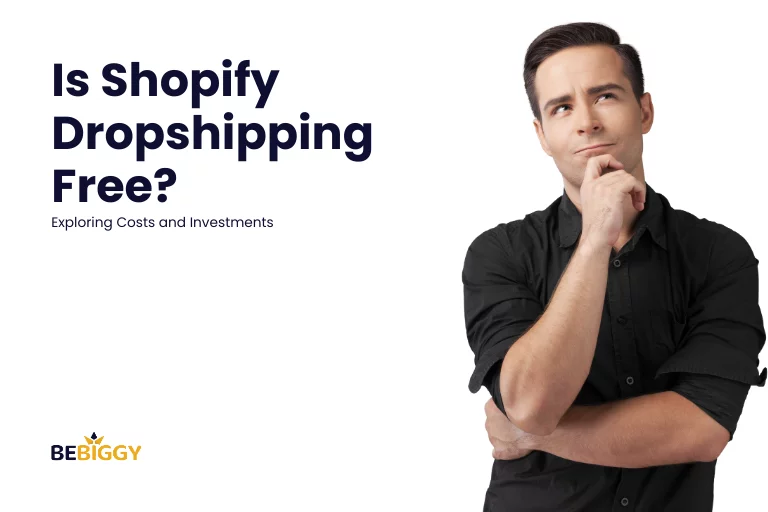








 What Is Shopify Dropshipping and How Does It Work?
What Is Shopify Dropshipping and How Does It Work? 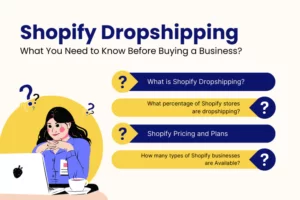 Shopify Dropshipping: What You Need to Know Before Buying a Business?
Shopify Dropshipping: What You Need to Know Before Buying a Business?  How to Dropship on Shopify: Step-by-Step Guide
How to Dropship on Shopify: Step-by-Step Guide  Guide to Finding Reliable Shopify Dropshipping Suppliers [100% Success]
Guide to Finding Reliable Shopify Dropshipping Suppliers [100% Success]